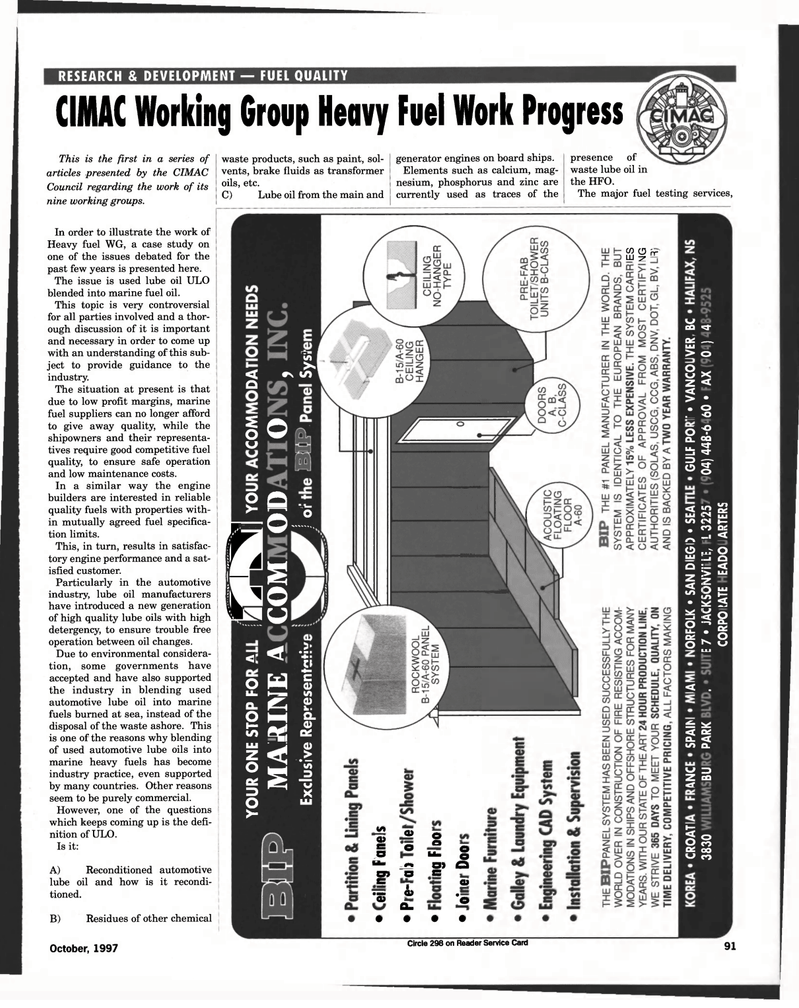
Page 81: of Maritime Reporter Magazine (October 1997)
Read this page in Pdf, Flash or Html5 edition of October 1997 Maritime Reporter Magazine
RESEARCH & DEVELOPMENT — FUEL QUALITY
CIMAC Working Group Heavy Fuel Work Progress
This is the first in a series of articles presented by the CIMAC
Council regarding the work of its nine working groups.
In order to illustrate the work of
Heavy fuel WG, a case study on one of the issues debated for the past few years is presented here.
The issue is used lube oil ULO blended into marine fuel oil.
This topic is very controversial for all parties involved and a thor- ough discussion of it is important and necessary in order to come up with an understanding of this sub- ject to provide guidance to the industry.
The situation at present is that due to low profit margins, marine fuel suppliers can no longer afford to give away quality, while the shipowners and their representa- tives require good competitive fuel quality, to ensure safe operation and low maintenance costs.
In a similar way the engine builders are interested in reliable quality fuels with properties with- in mutually agreed fuel specifica- tion limits.
This, in turn, results in satisfac- tory engine performance and a sat- isfied customer.
Particularly in the automotive industry, lube oil manufacturers have introduced a new generation of high quality lube oils with high detergency, to ensure trouble free operation between oil changes.
Due to environmental considera- tion, some governments have accepted and have also supported the industry in blending used automotive lube oil into marine fuels burned at sea, instead of the disposal of the waste ashore. This is one of the reasons why blending of used automotive lube oils into marine heavy fuels has become industry practice, even supported by many countries. Other reasons seem to be purely commercial.
However, one of the questions which keeps coming up is the defi- nition of ULO.
Is it:
A) Reconditioned automotive lube oil and how is it recondi- tioned. waste products, such as paint, sol- vents, brake fluids as transformer oils, etc.
C) Lube oil from the main and generator engines on board ships.
Elements such as calcium, mag- nesium, phosphorus and zinc are currently used as traces of the presence of waste lube oil in the HFO.
The major fuel testing services,
W CD fr lu 2 < • Q
IO u in X rs wo r
L: o o >- o o s o . u <
LL. CO a. 2> 0 o-h- a> co fig oc uj a>
Z < > 1 I
O u >-
B) Residues of other chemical
M q> 0> o s &' o © o 8 Ub
Burn .#»» 8» o g> 8
I o> jjj a> '35 *© Q. • • • • u
CO <3-
OS — Sif > o is < > • • o . -o
O -9
CL OO s 5 3f < ^ £ UJ CH K «/> N I— . CO Q£
A -• < 0 o UJ j Q 1 52 a is • ^ s ^ 4 o o - £ u. • ir oc O
O ^ w
LU
< .
£ ^ < Qg
ou < to CL
u ZD Z OQ
Is Q£ oo
<~> CO
October, 1997 Circle 298 on Reader Service Card 91

 80
80

 82
82
